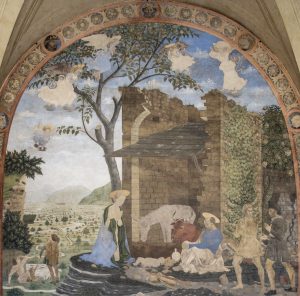A New Life for the Cloister of the Vows’ Frescoes

What has been a four-year project, to restore the frescoes in the Cloister of the Vows of the church of Santissima Annunziata made possible by the non-profit organization ‘Friends of Florence’, has finally reached its completion.
Restorers Alessandra Popple and Cristiana Conti from S.A.R., and Gioia Germani have impeded the deterioration of the murals while restoring their original luminosity.
La chiesa della madre di tutti fiorentini, as the mother church of the Servite order was known, was founded in 1234 and rebuilt between 1447 and 1452. Thanks to the miraculous fresco of the Annunciation inside the church, supposedly painted by an angel, it played a central part in Florentine daily life.
The cloister’s name (Il Chiostrino dei Voti) comes from the common practice of providing religious offerings to the Virgin Mary, in the form of oil lamps and candles.
Displayed in the lunettes of the cloister are 12 of the most impressive and delicate Florentine frescoes, some in Mannerist style, that narrate the lives of the Madonna and Filippo Benizi.
Dampness in the walls and light coming through the atrium caused the frescoes to lose their colour and cohesiveness over the years.
The first attempt to save the frescoes began in 1833 when The Great Duke Leopoldo II enclosed the area of the atrium. The current cast iron and glass skylight was installed in 1913, yet this did not resolve the deterioration of the paintings.
Treatment to protect the walls from humidity was applied following the events of World War II, but also proved insufficient. After the Flood of 1966, a restoration campaign was carried out by Dino Dini, who detached the individual frescoes from the walls and placed them on new supports. With the passing of 50 years, the lunettes were again in dire need of attention.
Friends of Florence raised a total of €467.000.00 for the fresco restoration project from benefactors between 2013 and 2017, something which the City of Florence is highly proud of.
S.A.R and Gioia Germani used inorganic substances such as Barium and Ammonium carbonates to restore the damaged layers of the paintings to the highest quality possible. Although this technique may also affect the luminosity of the piece, the substances used saturate the pigments to create a brightening effect.
Alessio Baldovinetti painted the earliest fresco, the Nativity, in 1460. Around 1475, Cosimo Rosselli composed the first scene of a fresco cycle, the dressing of Saint Filippo, dedicated to the general superior of the Servites, Filippo Benizi.
Beginning in 1509 Andrea del Sarto, finished Rosselli’s work in two years, providing an extra five scenes. He later painted, The Voyage of the Magi (1511), and The Birth of the Virgin, completed around 1513-14. Andrea, whose career flourished during the High Rennaissance and Early Mannerism in Florence, created most of the frescoes exhibited in the cloister. To celebrate and remember his work, Giovanni Caccini created a marble bust of the painter, now amongst the frescoes.
Working alongside Andrea at the time were, his colleague, Franciabigio with The Betrothal of the Virgin (1513), and his students Pontormo with Visitation (1515) and Rosso Fiorentino with The Assumption of the Virgin (1517).
AN IN-DEPTH LOOK AT SOME OF THE FRESCOES:
Alessio Baldovinetti, who is said to have had a keen eye and interest for landscapes, depicts the birth of Christ and the adoration of the Kings and Shepherds, in his Nativity, using the Arno Valley as the background setting.
Baldovinetti painted only a few elements in true fresco, and waited until the plaster had dried to paint a ‘secco.’ Located in an area exposed to winter temperatures, the depicted faces, hands and drapery peeled off, revealing his underdrawings.
The horizon background links the birth of Christ to ‘a new beginning,’ reinforced by the angels in the sky who have come to visit. The Virgin adoring the newborn almost appears 2D, through the use of bolder colours of green and blue, in contrast with the grey-fading colour of the surrounding characters. This depiction of the Virgin successfully renders the image of an angel and her glowing silhouette that will cherish and protect this new and precious future leader.
In the Assumption of the Virgin, Rosso Fiorentino distinctively portrays the Virgin’s rise to Heaven. The contrasting colours of the gold sky and lavender-tones of the clouds, create a feeling of warmth and mysticality, and also help create a clear divide, both socially and physically, between the Virgin and cherubs from the apostles on the ground looking on in awe.
The Punishment of Blasphemers by del Sarto is particularly captivating for the different tones and shades used in order to create the ‘opening’ of the heavens and the destruction, taking place on earth.
In the scene, the faint orange lightning bolt that is breaking down a tree is not instantly visible upon first glance. This is due to the thick black and purple of the cloud-filled sky from which it is emanating; however, once noticed it is an element that becomes the focal point of the piece. The rural landscape that del Sarto uses as the backdrop is equally as eye-catching, creating a multi-faceted artwork.
Those interested in 15th and 16th century art may now visit one of Italy’s most fascinating collections of frescoes, all made possible through the work of Friends of Florence. (karen gee)
